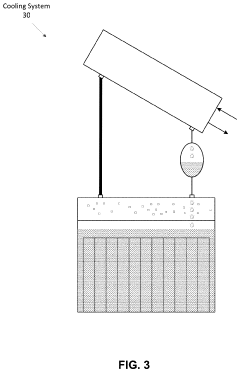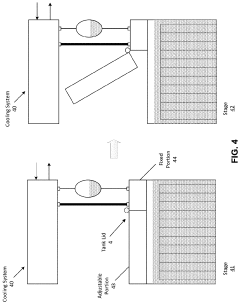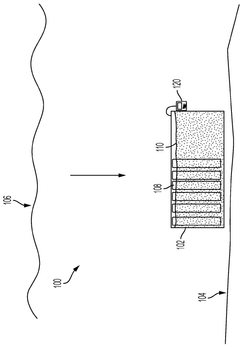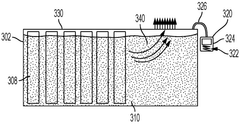Retrofit Strategies For Existing Data Centers To Immersion Cooling
AUG 22, 20259 MIN READ
Generate Your Research Report Instantly with AI Agent
Patsnap Eureka helps you evaluate technical feasibility & market potential.
Immersion Cooling Evolution and Objectives
Immersion cooling technology has evolved significantly over the past three decades, transitioning from niche applications in military and supercomputing environments to becoming an increasingly mainstream solution for data center thermal management. The first commercial implementations in the 1980s utilized single-phase immersion cooling, where electronic components were submerged in non-conductive dielectric fluids that absorbed heat without undergoing phase change. These early systems demonstrated the fundamental viability of the approach but were limited by fluid properties and system design constraints.
The 2000s marked a pivotal evolution with the introduction of two-phase immersion cooling systems, where the dielectric fluid boils upon contact with hot components, creating a highly efficient heat transfer mechanism through the phase change process. This innovation dramatically improved cooling efficiency, allowing for higher power densities and reduced pumping requirements compared to single-phase predecessors.
Recent technological advancements have focused on fluid chemistry optimization, with modern dielectric fluids offering improved thermal properties, environmental sustainability, and compatibility with electronic components. Simultaneously, immersion cooling infrastructure has evolved to address practical implementation challenges, including fluid containment, maintenance access, and integration with existing facility systems.
The primary objective of immersion cooling retrofit strategies is to enable existing data centers to accommodate significantly higher power densities without requiring extensive facility reconstruction or expansion. Modern high-performance computing applications, particularly those involving AI accelerators and dense GPU deployments, often demand cooling capacities exceeding 50kW per rack—well beyond the capabilities of conventional air cooling systems.
Additional objectives include substantial improvement in energy efficiency metrics, with immersion cooling potentially reducing cooling-related power consumption by 30-50% compared to traditional air cooling. This translates directly to lower operational expenses and improved PUE (Power Usage Effectiveness) metrics, addressing both economic and sustainability imperatives.
Noise reduction represents another important objective, as immersion cooling eliminates the need for numerous high-speed fans, creating quieter operational environments. This benefit extends beyond operator comfort to potentially reducing acoustic isolation requirements and associated construction costs.
Long-term objectives include enabling more flexible data center designs that can adapt to evolving computational requirements without fundamental infrastructure changes. By providing cooling capacity headroom, immersion solutions aim to future-proof facilities against the continuing trend of increasing power densities in computing hardware, extending the operational lifespan of existing data center investments.
The 2000s marked a pivotal evolution with the introduction of two-phase immersion cooling systems, where the dielectric fluid boils upon contact with hot components, creating a highly efficient heat transfer mechanism through the phase change process. This innovation dramatically improved cooling efficiency, allowing for higher power densities and reduced pumping requirements compared to single-phase predecessors.
Recent technological advancements have focused on fluid chemistry optimization, with modern dielectric fluids offering improved thermal properties, environmental sustainability, and compatibility with electronic components. Simultaneously, immersion cooling infrastructure has evolved to address practical implementation challenges, including fluid containment, maintenance access, and integration with existing facility systems.
The primary objective of immersion cooling retrofit strategies is to enable existing data centers to accommodate significantly higher power densities without requiring extensive facility reconstruction or expansion. Modern high-performance computing applications, particularly those involving AI accelerators and dense GPU deployments, often demand cooling capacities exceeding 50kW per rack—well beyond the capabilities of conventional air cooling systems.
Additional objectives include substantial improvement in energy efficiency metrics, with immersion cooling potentially reducing cooling-related power consumption by 30-50% compared to traditional air cooling. This translates directly to lower operational expenses and improved PUE (Power Usage Effectiveness) metrics, addressing both economic and sustainability imperatives.
Noise reduction represents another important objective, as immersion cooling eliminates the need for numerous high-speed fans, creating quieter operational environments. This benefit extends beyond operator comfort to potentially reducing acoustic isolation requirements and associated construction costs.
Long-term objectives include enabling more flexible data center designs that can adapt to evolving computational requirements without fundamental infrastructure changes. By providing cooling capacity headroom, immersion solutions aim to future-proof facilities against the continuing trend of increasing power densities in computing hardware, extending the operational lifespan of existing data center investments.
Market Demand for Data Center Cooling Solutions
The global data center cooling market is experiencing unprecedented growth, driven by the exponential increase in data generation and processing requirements. Current market valuations place the data center cooling sector at approximately 8 billion USD in 2022, with projections indicating a compound annual growth rate (CAGR) of 15-17% through 2030. This remarkable expansion reflects the critical importance of effective thermal management solutions in modern computing environments.
Traditional air cooling systems, which currently dominate approximately 85% of the market, are increasingly struggling to meet the thermal demands of high-density computing. This limitation has created a significant market opportunity for immersion cooling technologies, which offer superior heat dissipation capabilities and energy efficiency benefits.
Industry surveys indicate that data center operators identify cooling as their second highest operational expense, accounting for 30-40% of total energy consumption in typical facilities. With electricity costs continuing to rise globally and environmental regulations becoming more stringent, the economic incentives for adopting more efficient cooling solutions have never been stronger.
The demand for immersion cooling retrofits is particularly pronounced in regions with high electricity costs and strict carbon emission regulations, such as Western Europe, Japan, and parts of North America. Additionally, emerging markets in Southeast Asia and the Middle East are showing accelerated interest as they rapidly expand their digital infrastructure while facing challenging climate conditions.
Market segmentation analysis reveals that hyperscale data centers and high-performance computing (HPC) facilities represent the most promising immediate markets for immersion cooling retrofits. These segments prioritize performance optimization and have the capital resources to invest in advanced cooling technologies. The cryptocurrency mining sector, despite its volatility, has also emerged as an early adopter of immersion cooling solutions.
Customer surveys indicate that data center operators are primarily motivated by three factors when considering cooling system upgrades: operational cost reduction (energy efficiency), increased computing density capabilities, and environmental sustainability improvements. Immersion cooling solutions address all three concerns, positioning them favorably against competing technologies.
Market forecasts suggest that by 2025, immersion cooling will capture approximately 15% of the total data center cooling market, representing a significant shift from its current 3-4% market share. This transition is expected to accelerate as more case studies demonstrate successful retrofits of existing facilities, thereby reducing perceived implementation risks and encouraging broader adoption across the industry.
Traditional air cooling systems, which currently dominate approximately 85% of the market, are increasingly struggling to meet the thermal demands of high-density computing. This limitation has created a significant market opportunity for immersion cooling technologies, which offer superior heat dissipation capabilities and energy efficiency benefits.
Industry surveys indicate that data center operators identify cooling as their second highest operational expense, accounting for 30-40% of total energy consumption in typical facilities. With electricity costs continuing to rise globally and environmental regulations becoming more stringent, the economic incentives for adopting more efficient cooling solutions have never been stronger.
The demand for immersion cooling retrofits is particularly pronounced in regions with high electricity costs and strict carbon emission regulations, such as Western Europe, Japan, and parts of North America. Additionally, emerging markets in Southeast Asia and the Middle East are showing accelerated interest as they rapidly expand their digital infrastructure while facing challenging climate conditions.
Market segmentation analysis reveals that hyperscale data centers and high-performance computing (HPC) facilities represent the most promising immediate markets for immersion cooling retrofits. These segments prioritize performance optimization and have the capital resources to invest in advanced cooling technologies. The cryptocurrency mining sector, despite its volatility, has also emerged as an early adopter of immersion cooling solutions.
Customer surveys indicate that data center operators are primarily motivated by three factors when considering cooling system upgrades: operational cost reduction (energy efficiency), increased computing density capabilities, and environmental sustainability improvements. Immersion cooling solutions address all three concerns, positioning them favorably against competing technologies.
Market forecasts suggest that by 2025, immersion cooling will capture approximately 15% of the total data center cooling market, representing a significant shift from its current 3-4% market share. This transition is expected to accelerate as more case studies demonstrate successful retrofits of existing facilities, thereby reducing perceived implementation risks and encouraging broader adoption across the industry.
Current Immersion Cooling Technologies and Barriers
Immersion cooling technologies have evolved significantly over the past decade, with two primary categories now dominating the market: single-phase and two-phase immersion cooling. Single-phase systems utilize dielectric fluids that remain in liquid form throughout the cooling process. Heat is transferred from components to the liquid, which is then circulated through heat exchangers to dissipate thermal energy. These systems offer operational simplicity and lower implementation costs compared to their two-phase counterparts.
Two-phase immersion cooling leverages the phase change properties of specialized dielectric fluids. As components generate heat, the fluid evaporates, carrying heat away through the phase transition. The vapor then condenses at cooling coils and returns to liquid form, creating a highly efficient thermal transfer cycle. This approach delivers superior cooling efficiency, with potential PUE (Power Usage Effectiveness) values approaching 1.02-1.05, significantly outperforming traditional air cooling methods.
Despite these advantages, several substantial barriers impede widespread adoption of immersion cooling retrofits in existing data centers. The most significant challenge is the substantial capital expenditure required for implementation, including specialized tanks, fluid costs (which can exceed $15 per liter), and facility modifications. For large data centers, this investment can reach millions of dollars, creating difficult ROI calculations for operators of facilities not nearing end-of-life.
Compatibility issues present another major obstacle. Many existing server designs incorporate components not optimized for immersion, such as certain capacitors, connectors, and thermal interface materials that may degrade when submerged. Additionally, standard server form factors often require modification for optimal immersion performance, potentially voiding warranties and complicating maintenance procedures.
Operational barriers further complicate adoption. Staff require specialized training for handling dielectric fluids and maintaining immersion systems. Concerns about fluid degradation over time, potential leakage risks, and environmental impacts of certain fluids create additional hesitation. The industry also lacks comprehensive standardization for immersion cooling implementations, creating uncertainty around best practices and interoperability.
Infrastructure limitations in existing facilities present practical challenges. Many data centers lack sufficient floor loading capacity to support the weight of immersion tanks filled with dielectric fluid. Retrofitting may require structural reinforcements or limit deployment to specific zones. Additionally, existing power and cooling distribution systems typically require significant reconfiguration to accommodate immersion cooling's different operational parameters.
Two-phase immersion cooling leverages the phase change properties of specialized dielectric fluids. As components generate heat, the fluid evaporates, carrying heat away through the phase transition. The vapor then condenses at cooling coils and returns to liquid form, creating a highly efficient thermal transfer cycle. This approach delivers superior cooling efficiency, with potential PUE (Power Usage Effectiveness) values approaching 1.02-1.05, significantly outperforming traditional air cooling methods.
Despite these advantages, several substantial barriers impede widespread adoption of immersion cooling retrofits in existing data centers. The most significant challenge is the substantial capital expenditure required for implementation, including specialized tanks, fluid costs (which can exceed $15 per liter), and facility modifications. For large data centers, this investment can reach millions of dollars, creating difficult ROI calculations for operators of facilities not nearing end-of-life.
Compatibility issues present another major obstacle. Many existing server designs incorporate components not optimized for immersion, such as certain capacitors, connectors, and thermal interface materials that may degrade when submerged. Additionally, standard server form factors often require modification for optimal immersion performance, potentially voiding warranties and complicating maintenance procedures.
Operational barriers further complicate adoption. Staff require specialized training for handling dielectric fluids and maintaining immersion systems. Concerns about fluid degradation over time, potential leakage risks, and environmental impacts of certain fluids create additional hesitation. The industry also lacks comprehensive standardization for immersion cooling implementations, creating uncertainty around best practices and interoperability.
Infrastructure limitations in existing facilities present practical challenges. Many data centers lack sufficient floor loading capacity to support the weight of immersion tanks filled with dielectric fluid. Retrofitting may require structural reinforcements or limit deployment to specific zones. Additionally, existing power and cooling distribution systems typically require significant reconfiguration to accommodate immersion cooling's different operational parameters.
Retrofit Implementation Methodologies
01 Retrofitting existing data centers for immersion cooling
Methods and systems for converting traditional air-cooled data centers to immersion cooling technology without requiring complete infrastructure replacement. These retrofitting approaches include modifying existing server racks, implementing transitional cooling solutions, and adapting power distribution systems to accommodate immersion cooling requirements while minimizing operational disruption during the conversion process.- Retrofitting existing data centers for immersion cooling: Methods and systems for converting traditional air-cooled data centers to immersion cooling technology without requiring complete infrastructure replacement. These retrofitting approaches include modifying existing server racks to accommodate immersion cooling tanks, implementing transitional cooling solutions during the conversion process, and adapting power distribution systems to support immersion-cooled equipment while maintaining operational continuity.
- Modular immersion cooling systems for easy installation: Modular immersion cooling solutions designed for simplified retrofit applications in existing facilities. These systems feature pre-assembled cooling units that can be installed with minimal disruption to ongoing operations, standardized interfaces for connecting to existing infrastructure, and scalable designs that allow for gradual implementation across data center environments without requiring complete shutdown.
- Thermal management techniques for retrofitted immersion cooling: Advanced thermal management approaches specifically designed for retrofitted immersion cooling systems. These techniques include optimized coolant circulation patterns to address thermal hotspots in converted equipment, heat exchanger designs that integrate with existing building cooling infrastructure, and temperature monitoring systems adapted for immersion environments to ensure proper cooling performance in retrofitted setups.
- Fluid handling and maintenance systems for retrofit applications: Specialized fluid handling and maintenance solutions for retrofitted immersion cooling installations. These systems include coolant filtration and treatment equipment designed for retrofit scenarios, fluid level management systems that accommodate varied equipment geometries in converted racks, and maintenance access features that allow for servicing immersion-cooled components without disrupting adjacent systems.
- Power distribution and safety adaptations for immersion cooling retrofits: Modified power distribution architectures and safety systems for retrofitting existing facilities with immersion cooling technology. These adaptations include electrical isolation techniques for submerged components, specialized power delivery systems compatible with dielectric fluids, and safety monitoring equipment designed to detect potential hazards in converted immersion cooling environments while maintaining compliance with relevant standards.
02 Modular immersion cooling systems for easy installation
Modular immersion cooling solutions designed specifically for retrofit applications, featuring pre-assembled units that can be easily integrated into existing infrastructure. These systems include self-contained immersion tanks, plug-and-play connections, and standardized interfaces that allow for gradual implementation without major facility modifications, enabling phased migration from traditional cooling to immersion cooling.Expand Specific Solutions03 Hybrid cooling approaches for transitional implementation
Hybrid cooling technologies that combine elements of traditional air cooling with immersion cooling, allowing for staged implementation in existing facilities. These solutions provide a transitional pathway that enables partial immersion cooling deployment while maintaining compatibility with legacy systems, reducing initial investment costs and allowing for performance validation before full conversion.Expand Specific Solutions04 Dielectric fluid management systems for retrofitted environments
Specialized fluid management systems designed for retrofitted immersion cooling installations, including fluid circulation, filtration, and heat exchange components. These systems address the challenges of introducing dielectric cooling fluids into existing data center environments, with features for fluid monitoring, maintenance, containment, and thermal management optimized for retrofit scenarios.Expand Specific Solutions05 Power and thermal management adaptations for retrofitted immersion cooling
Methods for adapting existing power distribution and thermal management systems to support immersion cooling in retrofitted environments. These adaptations include modified electrical connections, enhanced safety features for submerged electronics, optimized heat exchanger configurations, and control systems that manage the thermal characteristics of immersion-cooled hardware within the constraints of existing facility infrastructure.Expand Specific Solutions
Key Industry Players in Immersion Cooling
The immersion cooling retrofit market for data centers is in a growth phase, driven by increasing power densities and sustainability demands. The market size is expanding rapidly, with projections showing significant adoption over the next five years as traditional air cooling reaches efficiency limits. Technologically, immersion cooling is maturing with varying levels of implementation readiness across providers. Companies like Green Revolution Cooling and DataBean have established specialized immersion cooling solutions, while major players including Microsoft, Fujitsu, and Baidu are actively developing proprietary systems. Asian manufacturers such as Wiwynn, Inventec, and Pegatron are integrating immersion-ready hardware, while research institutions like Southeast University and Xi'an Jiaotong University are advancing the fundamental technology. The ecosystem shows a blend of specialized cooling providers and traditional IT companies adapting to this cooling paradigm.
Microsoft Technology Licensing LLC
Technical Solution: Microsoft has developed a sophisticated immersion cooling retrofit strategy for their global data center fleet, focusing on sustainability and operational efficiency. Their approach utilizes a proprietary two-phase immersion cooling system where servers are submerged in a specialized engineered fluid that boils at 122°F (50°C), creating an efficient heat transfer mechanism through phase change. Microsoft's retrofit methodology involves modular "cooling tanks" that can be deployed within existing data center spaces, requiring minimal structural modifications. Their system eliminates the need for traditional cooling infrastructure components like chillers, cooling towers, and computer room air handlers, potentially reducing energy consumption for cooling by over 95%. Microsoft has also developed specialized server designs optimized for immersion, featuring sealed power supplies and modified component layouts. Their implementation includes advanced telemetry systems that monitor fluid conditions, thermal performance, and server health in real-time. Microsoft's strategy also incorporates heat recovery systems that can repurpose waste heat for facility heating or other applications, further improving overall energy efficiency.
Strengths: Highly scalable modular implementation; significant reduction in cooling infrastructure; advanced monitoring and management systems; potential for waste heat recovery; enables higher power density computing. Weaknesses: Requires specialized server designs for optimal performance; higher initial capital expenditure; operational complexity in fluid management and maintenance; potential challenges with hardware servicing in immersion environment.
Green Revolution Cooling, Inc.
Technical Solution: Green Revolution Cooling (GRC) has pioneered single-phase immersion cooling technology with their CarnotJet System, which submerges servers directly in a dielectric fluid called ElectroSafe. Their retrofit strategy focuses on modular deployment, allowing data centers to transition incrementally without complete facility shutdown. GRC's approach includes custom-designed immersion tanks that can be installed alongside existing air-cooled infrastructure, enabling a phased migration. Their system eliminates the need for raised floors, computer room air conditioning units, and chillers, potentially reducing cooling energy consumption by up to 95% and total data center power usage by up to 50%. GRC's technology also features a closed-loop cooling system that transfers heat from the dielectric fluid to a water loop via plate heat exchangers, which can then be used for heat recovery applications or rejected through existing cooling towers.
Strengths: Modular implementation allows for gradual transition without disrupting operations; eliminates need for raised floors and traditional CRAC units; significantly reduces cooling energy costs; enables higher density computing (up to 100 kW per rack). Weaknesses: Requires specialized maintenance procedures for fluid handling; initial capital investment can be substantial; some server components may need modification for optimal immersion performance.
Critical Patents and Technical Innovations
Cooling systems for immersion cooled it equipment
PatentActiveUS20210153392A1
Innovation
- A full-end-to-end immersion cooling system that maintains a coolant level while allowing maintenance without breaking the cooling loop, featuring a condenser positioned above the IT equipment, a return line, and a supply line, along with a valve and liquid level sensor to control coolant levels, enabling flexible deployment in existing data centers or separate modules.
Systems, methods, and apparatus for placing data centers in a subsea environment
PatentWO2025096826A1
Innovation
- The placement of data centers in a subsea environment using immersion cooling technology, where servers are submerged in dielectric fluid within a pressure-compensated metal enclosure, leveraging natural convection and the surrounding seawater for passive cooling.
TCO Analysis for Retrofit Projects
The Total Cost of Ownership (TCO) analysis for retrofitting existing data centers to immersion cooling requires a comprehensive evaluation of both initial capital expenditures and long-term operational costs. When comparing traditional air cooling with immersion cooling solutions, organizations must consider multiple financial dimensions to make informed decisions.
Initial retrofit costs typically include the immersion tanks, compatible IT equipment modifications, cooling distribution units, heat exchangers, and the specialized dielectric fluid. These capital expenses often represent the most significant barrier to adoption, with fluid costs alone potentially reaching $10-15 per liter, requiring thousands of liters for medium to large deployments. Hardware modifications may add 15-20% to standard server costs to ensure compatibility with immersion environments.
Infrastructure modification expenses vary significantly based on the existing facility design. Data centers with raised floors may require substantial structural reinforcement to support the weight of immersion tanks and fluid. Electrical systems often need reconfiguration to accommodate the different power distribution requirements, while plumbing systems require installation for fluid circulation and cooling loops.
Operational expenditure analysis reveals significant potential savings that offset initial investments. Power consumption typically decreases by 25-40% compared to air cooling, primarily through the elimination of server fans and reduced cooling infrastructure. This translates to proportional reductions in electricity costs, which represent a major operational expense for data centers.
Maintenance costs generally decrease with immersion cooling due to reduced mechanical components and lower failure rates in the controlled thermal environment. Studies indicate a 30% reduction in hardware failures and extended equipment lifespan by 1-2 years, significantly impacting long-term replacement costs. However, specialized maintenance procedures for fluid management and periodic replacement (every 5-7 years) must be factored into operational budgets.
Space utilization improvements deliver additional economic benefits, with immersion cooling enabling 25-45% higher compute density. This space efficiency can either extend the useful life of existing facilities or allow for increased computing capacity without physical expansion.
Return on investment calculations typically show breakeven periods of 2-4 years for large-scale implementations, with faster returns in regions with higher electricity costs or in facilities operating near thermal capacity. The TCO advantage increases proportionally with power density, making immersion cooling particularly attractive for high-performance computing environments.
Initial retrofit costs typically include the immersion tanks, compatible IT equipment modifications, cooling distribution units, heat exchangers, and the specialized dielectric fluid. These capital expenses often represent the most significant barrier to adoption, with fluid costs alone potentially reaching $10-15 per liter, requiring thousands of liters for medium to large deployments. Hardware modifications may add 15-20% to standard server costs to ensure compatibility with immersion environments.
Infrastructure modification expenses vary significantly based on the existing facility design. Data centers with raised floors may require substantial structural reinforcement to support the weight of immersion tanks and fluid. Electrical systems often need reconfiguration to accommodate the different power distribution requirements, while plumbing systems require installation for fluid circulation and cooling loops.
Operational expenditure analysis reveals significant potential savings that offset initial investments. Power consumption typically decreases by 25-40% compared to air cooling, primarily through the elimination of server fans and reduced cooling infrastructure. This translates to proportional reductions in electricity costs, which represent a major operational expense for data centers.
Maintenance costs generally decrease with immersion cooling due to reduced mechanical components and lower failure rates in the controlled thermal environment. Studies indicate a 30% reduction in hardware failures and extended equipment lifespan by 1-2 years, significantly impacting long-term replacement costs. However, specialized maintenance procedures for fluid management and periodic replacement (every 5-7 years) must be factored into operational budgets.
Space utilization improvements deliver additional economic benefits, with immersion cooling enabling 25-45% higher compute density. This space efficiency can either extend the useful life of existing facilities or allow for increased computing capacity without physical expansion.
Return on investment calculations typically show breakeven periods of 2-4 years for large-scale implementations, with faster returns in regions with higher electricity costs or in facilities operating near thermal capacity. The TCO advantage increases proportionally with power density, making immersion cooling particularly attractive for high-performance computing environments.
Environmental Impact and Sustainability Benefits
Immersion cooling retrofits for data centers offer substantial environmental and sustainability advantages compared to traditional air cooling systems. The elimination of energy-intensive computer room air conditioning (CRAC) units can reduce overall energy consumption by 30-50%, directly translating to lower carbon emissions. This significant reduction stems from both decreased cooling energy requirements and the ability to operate servers at higher densities without thermal constraints.
The heat recovery potential represents another major environmental benefit. Immersion cooling systems capture waste heat more efficiently than air-based systems, with liquid coolants able to maintain temperatures between 50-60°C. This high-quality waste heat can be repurposed for district heating, greenhouse operations, or other industrial processes, creating circular energy systems that maximize resource utilization.
Water conservation presents a compelling sustainability advantage. While traditional data centers consume substantial amounts of water for evaporative cooling towers, immersion cooling systems operate in closed loops with minimal water requirements. Studies indicate potential water savings of up to 95% compared to conventional cooling methods, a critical benefit in regions facing water scarcity challenges.
The lifecycle environmental impact of immersion cooling also merits consideration. Modern dielectric fluids used in immersion systems have significantly improved environmental profiles compared to earlier generations, with many being biodegradable and having low global warming potential. Additionally, the extended equipment lifespan resulting from more consistent operating temperatures reduces electronic waste generation, addressing another environmental concern in the technology sector.
Carbon footprint reduction extends beyond operational efficiency. The compact nature of immersion cooling installations reduces construction material requirements and associated embodied carbon. Furthermore, the higher power density enables more computing capacity within existing building footprints, potentially reducing the need for new data center construction and the associated environmental impacts.
From a regulatory perspective, immersion cooling retrofits position data centers advantageously as environmental regulations tighten globally. Many jurisdictions are implementing stricter energy efficiency requirements and carbon pricing mechanisms that will increasingly penalize inefficient cooling technologies. Early adoption of immersion cooling provides a pathway to compliance with emerging sustainability mandates while delivering operational cost benefits.
The heat recovery potential represents another major environmental benefit. Immersion cooling systems capture waste heat more efficiently than air-based systems, with liquid coolants able to maintain temperatures between 50-60°C. This high-quality waste heat can be repurposed for district heating, greenhouse operations, or other industrial processes, creating circular energy systems that maximize resource utilization.
Water conservation presents a compelling sustainability advantage. While traditional data centers consume substantial amounts of water for evaporative cooling towers, immersion cooling systems operate in closed loops with minimal water requirements. Studies indicate potential water savings of up to 95% compared to conventional cooling methods, a critical benefit in regions facing water scarcity challenges.
The lifecycle environmental impact of immersion cooling also merits consideration. Modern dielectric fluids used in immersion systems have significantly improved environmental profiles compared to earlier generations, with many being biodegradable and having low global warming potential. Additionally, the extended equipment lifespan resulting from more consistent operating temperatures reduces electronic waste generation, addressing another environmental concern in the technology sector.
Carbon footprint reduction extends beyond operational efficiency. The compact nature of immersion cooling installations reduces construction material requirements and associated embodied carbon. Furthermore, the higher power density enables more computing capacity within existing building footprints, potentially reducing the need for new data center construction and the associated environmental impacts.
From a regulatory perspective, immersion cooling retrofits position data centers advantageously as environmental regulations tighten globally. Many jurisdictions are implementing stricter energy efficiency requirements and carbon pricing mechanisms that will increasingly penalize inefficient cooling technologies. Early adoption of immersion cooling provides a pathway to compliance with emerging sustainability mandates while delivering operational cost benefits.
Unlock deeper insights with Patsnap Eureka Quick Research — get a full tech report to explore trends and direct your research. Try now!
Generate Your Research Report Instantly with AI Agent
Supercharge your innovation with Patsnap Eureka AI Agent Platform!







